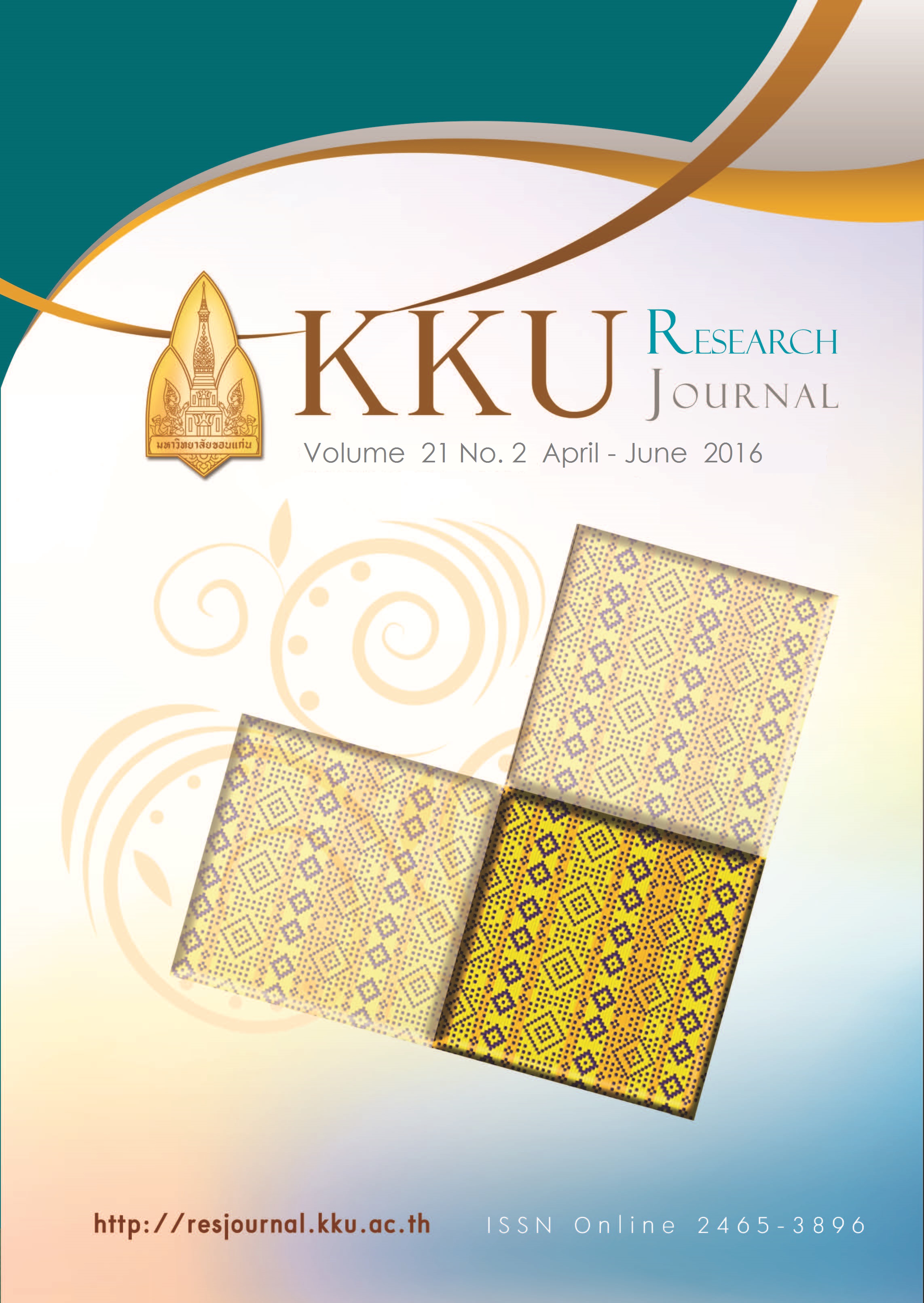Purification and characterization of heparin degrading enzyme by isolated bacteria from brackish sediment
Main Article Content
Abstract
The heparinase-producing bacteria was isolated from brackish sediment and identified by morphological characteristic and 16S rRNA gene. The nucleotide sequence of 16S rRNA indicated highest similarity (97%-100%) with genus Aeromonas. The isolate was subsequently described as Aeromonas sp. RYA_En1. The crude intracellular enzyme
produced by Aeromonas sp. RYA_En1 was partial purified by ammonium sulphate, ion exchange and gel filtration column chromatography, respectively. The active fraction obtained from gel filtration chromatography yielded enzyme production and enzyme specific activity of 410 U/L and 0.63 U/mg protein, respectively. Then, the purified fraction was determined for the optimal temperature and pH for the enzyme activities which were at 37°C and pH of 7.0, respectively. In addition, the molecular weight of the purified enzyme determined by the SDS-PAGE was approximately 90 kDa.
Article Details
References
[2] Limtiaco JF, Beni S, Jones CJ,Langeslay DJ, Larive CK. NMR methods to monitor the enzymatic depolymerization of heparin. Analytical and Bioanalytical Chemistry. 2011 Jan;399(2):593-603.
[3] Linhardt RJ, Galliher PM, CooneyCL. Polysaccharide lyases. Applied Biochemistry and Biotechnology.1986 Apr;12(2):135-76.
[4] Linhardt RJ, Turnbull JE, Wang HM, Loganathan D, Gallagher JT. Examination of the substrate specificity of heparin and heparan sulfate lyases. Biochemistry. 1990
Mar 29(10):2611-7.
[5] Yapeng C, Ningguo G, Xiulan C, Jing Y, Shijun Q, Shuzheng Z. Rapid purification, characterization
and substrate specificity of heparinase from a novel species of Sphingobacterium. Journal Biochemistry. 2003 Sep;134(3):365-71. KKU Res. J. 2016; 21(2)
[6] Yoshida E, Sakai K, Tokuyama S, Miyazono H, Maruyama H, Morikawa K, et al. Purification and characterization of heparinase that degrades both heparin and heparan sulfate from Bacillus circulans. Bioscience, Biotechnology, and
Biochemistry. 2002 May;66(5):1181-4.
[7] Kim WS, Kim BT, Kim DH, Kim YS. Purification and characterization of heparin lyase I from Bacteroides stercoris HJ-15. Journal of biochemistry and molecular biology. 2004 Nov 37(6):684-90.
[8] Watanabe M, Tsuda H, Yamada S, Shibata Y, Nakamura T, Sugahara K. Characterization of heparinase
from an oral bacterium Prevotella heparinolytica. J Biochem 1998 Feb;123(2):283-8.
[9] Banga J, Tripathi CK. Purification and characterization of a novel heparin degrading enzyme from Aspergillus flavus (MTCC-8654). Appl Biochem Biotechnol 2010 Feb;160(4):1004-16 doi: 101007/s12010-009-8530-2 Epub 2009 Feb 13.
[10] Gao N, Cheng X, Yang J, Zhang S. Strain screening and fermentation conditions of a novel heparinaseproducing
strain. Wei Sheng Wu Xue Bao. 1999 Feb;39(1):64-7.
[11] Laemmli UK. Cleavage of structural proteins during the assembly of the head of bacteriophage T4. Nature.1970 Aug 227(5259):680-5.
[12] Lohse DL, Linhardt RJ. Purification and characterization of heparin lyases from Flavobacterium heparinum. Journal of Biological Chemistry. 1992 Dec 267(34): 24347-55.
[13] Bradford MM. A rapid and sensitive method for the quantitation of microgram quantities of protein utilizing the principle of protein-dye binding. Analytical Biochemistry. 1976 May 72:248-54.
[14] Payza AN, Korn ED. Bacterial degradation of heparin. Nature. 1956 Jan 177(4498):88-9.
[15] Nakamura T, Shibata Y, Fujimura S. Purification and properties of Bacteroides heparinolyticus heparinase (heparin lyase, EC 4.2.2.7). J Clin Microbiol. 1988 May;26(5):1070-1.
[16] Banga J, Tripathi CK. Purification and characterization of a novel heparin degrading enzyme from Aspergillus flavus (MTCC-8654). Applied Biochemistry and Biotechnology. 2010 Feb;160(4):1004-16.


